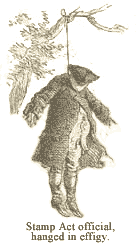The colony of New York was adversely affected by British policies in the period following the French and Indian War. British officials were interested in tightening imperial controls and taxing the colonists to provide for their protection and administrative costs.
 Like elsewhere, New Yorkers resisted these newly implemented policies and resorted to violent protest, particularly in the case of the Stamp Act. New York, however, did differ from some other colonies in that there existed a significant number of Loyalists within its ranks, perhaps as many as one half of the population. In fact, the colonial assembly in New York remained in Loyalist hands until some months after Lexington and Concord.
Like elsewhere, New Yorkers resisted these newly implemented policies and resorted to violent protest, particularly in the case of the Stamp Act. New York, however, did differ from some other colonies in that there existed a significant number of Loyalists within its ranks, perhaps as many as one half of the population. In fact, the colonial assembly in New York remained in Loyalist hands until some months after Lexington and Concord.
Many significant battles of the War for Independence were fought in New York. In the early stages, Americans gained confidence in victories at Fort Ticonderoga and Crown Point.
The tide turned in favor of the British in 1776 with victories on Long Island, Harlem Heights and Fort Washington, leading to the occupation of New York City and evacuation of the state government to Kingston.
In 1777, American fortunes were revived in the battles of Oriskany and Saratoga. Following 1778, military activity in New York lessened as the focus shifted to the South.